BTEC HND Business Project: NMB Bank, Globalization, and Banking Sector
VerifiedAdded on 2021/05/06
|44
|11710
|117
Project
AI Summary
This project report examines the impact of globalization on NMB Bank, a Nepalese financial institution. The study begins with definitions and the history of globalization, followed by an analysis of its effects on the banking sector at both international and national levels, with a specific focus on Nepal. The report includes a project management plan, covering cost analysis, risk management, action plans, and communication strategies. A work breakdown structure, Gantt chart, and milestones are also presented. The research employs a detailed methodology, leading to findings, recommendations, and conclusions. The project assesses the value of research and project management processes, incorporating a log book, risk assessment, and actual cost analysis, providing a comprehensive overview of globalization's influence on NMB Bank's operations and performance.

1/1/2019
Managing a successful business project
Bishal Gurung
BTEC HND in Business/ Second Semester Sec-A)
Managing a successful business project
Bishal Gurung
BTEC HND in Business/ Second Semester Sec-A)
Paraphrase This Document
Need a fresh take? Get an instant paraphrase of this document with our AI Paraphraser
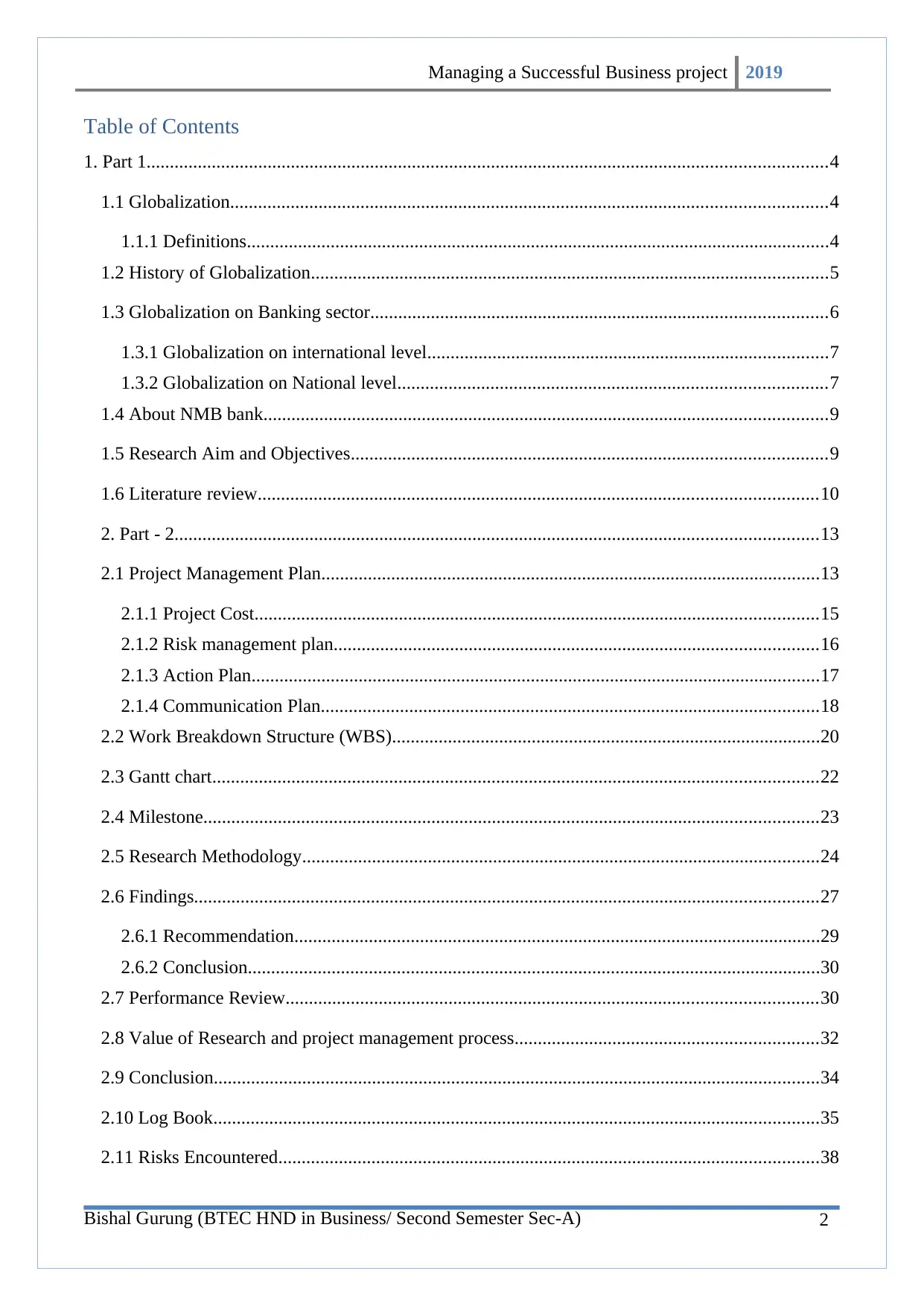
2
Managing a Successful Business project 2019
Table of Contents
1. Part 1..................................................................................................................................................4
1.1 Globalization................................................................................................................................4
1.1.1 Definitions.............................................................................................................................4
1.2 History of Globalization...............................................................................................................5
1.3 Globalization on Banking sector..................................................................................................6
1.3.1 Globalization on international level......................................................................................7
1.3.2 Globalization on National level............................................................................................7
1.4 About NMB bank.........................................................................................................................9
1.5 Research Aim and Objectives......................................................................................................9
1.6 Literature review........................................................................................................................10
2. Part - 2..........................................................................................................................................13
2.1 Project Management Plan...........................................................................................................13
2.1.1 Project Cost.........................................................................................................................15
2.1.2 Risk management plan........................................................................................................16
2.1.3 Action Plan..........................................................................................................................17
2.1.4 Communication Plan...........................................................................................................18
2.2 Work Breakdown Structure (WBS)............................................................................................20
2.3 Gantt chart..................................................................................................................................22
2.4 Milestone....................................................................................................................................23
2.5 Research Methodology...............................................................................................................24
2.6 Findings......................................................................................................................................27
2.6.1 Recommendation.................................................................................................................29
2.6.2 Conclusion...........................................................................................................................30
2.7 Performance Review..................................................................................................................30
2.8 Value of Research and project management process.................................................................32
2.9 Conclusion..................................................................................................................................34
2.10 Log Book..................................................................................................................................35
2.11 Risks Encountered....................................................................................................................38
Bishal Gurung (BTEC HND in Business/ Second Semester Sec-A)
Managing a Successful Business project 2019
Table of Contents
1. Part 1..................................................................................................................................................4
1.1 Globalization................................................................................................................................4
1.1.1 Definitions.............................................................................................................................4
1.2 History of Globalization...............................................................................................................5
1.3 Globalization on Banking sector..................................................................................................6
1.3.1 Globalization on international level......................................................................................7
1.3.2 Globalization on National level............................................................................................7
1.4 About NMB bank.........................................................................................................................9
1.5 Research Aim and Objectives......................................................................................................9
1.6 Literature review........................................................................................................................10
2. Part - 2..........................................................................................................................................13
2.1 Project Management Plan...........................................................................................................13
2.1.1 Project Cost.........................................................................................................................15
2.1.2 Risk management plan........................................................................................................16
2.1.3 Action Plan..........................................................................................................................17
2.1.4 Communication Plan...........................................................................................................18
2.2 Work Breakdown Structure (WBS)............................................................................................20
2.3 Gantt chart..................................................................................................................................22
2.4 Milestone....................................................................................................................................23
2.5 Research Methodology...............................................................................................................24
2.6 Findings......................................................................................................................................27
2.6.1 Recommendation.................................................................................................................29
2.6.2 Conclusion...........................................................................................................................30
2.7 Performance Review..................................................................................................................30
2.8 Value of Research and project management process.................................................................32
2.9 Conclusion..................................................................................................................................34
2.10 Log Book..................................................................................................................................35
2.11 Risks Encountered....................................................................................................................38
Bishal Gurung (BTEC HND in Business/ Second Semester Sec-A)
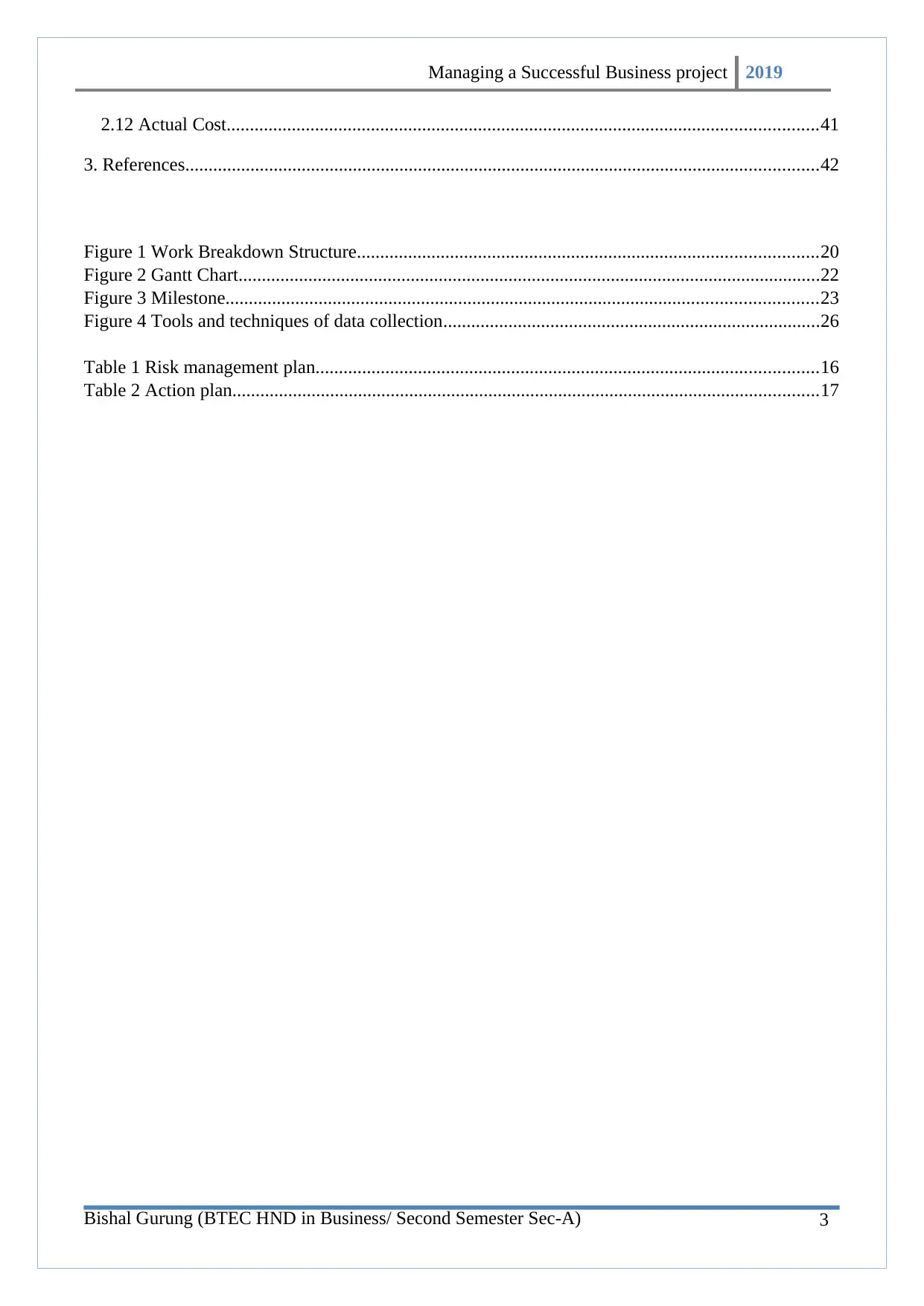
3
Managing a Successful Business project 2019
2.12 Actual Cost...............................................................................................................................41
3. References........................................................................................................................................42
Figure 1 Work Breakdown Structure...................................................................................................20
Figure 2 Gantt Chart.............................................................................................................................22
Figure 3 Milestone...............................................................................................................................23
Figure 4 Tools and techniques of data collection.................................................................................26
Table 1 Risk management plan............................................................................................................16
Table 2 Action plan..............................................................................................................................17
Bishal Gurung (BTEC HND in Business/ Second Semester Sec-A)
Managing a Successful Business project 2019
2.12 Actual Cost...............................................................................................................................41
3. References........................................................................................................................................42
Figure 1 Work Breakdown Structure...................................................................................................20
Figure 2 Gantt Chart.............................................................................................................................22
Figure 3 Milestone...............................................................................................................................23
Figure 4 Tools and techniques of data collection.................................................................................26
Table 1 Risk management plan............................................................................................................16
Table 2 Action plan..............................................................................................................................17
Bishal Gurung (BTEC HND in Business/ Second Semester Sec-A)
⊘ This is a preview!⊘
Do you want full access?
Subscribe today to unlock all pages.

Trusted by 1+ million students worldwide
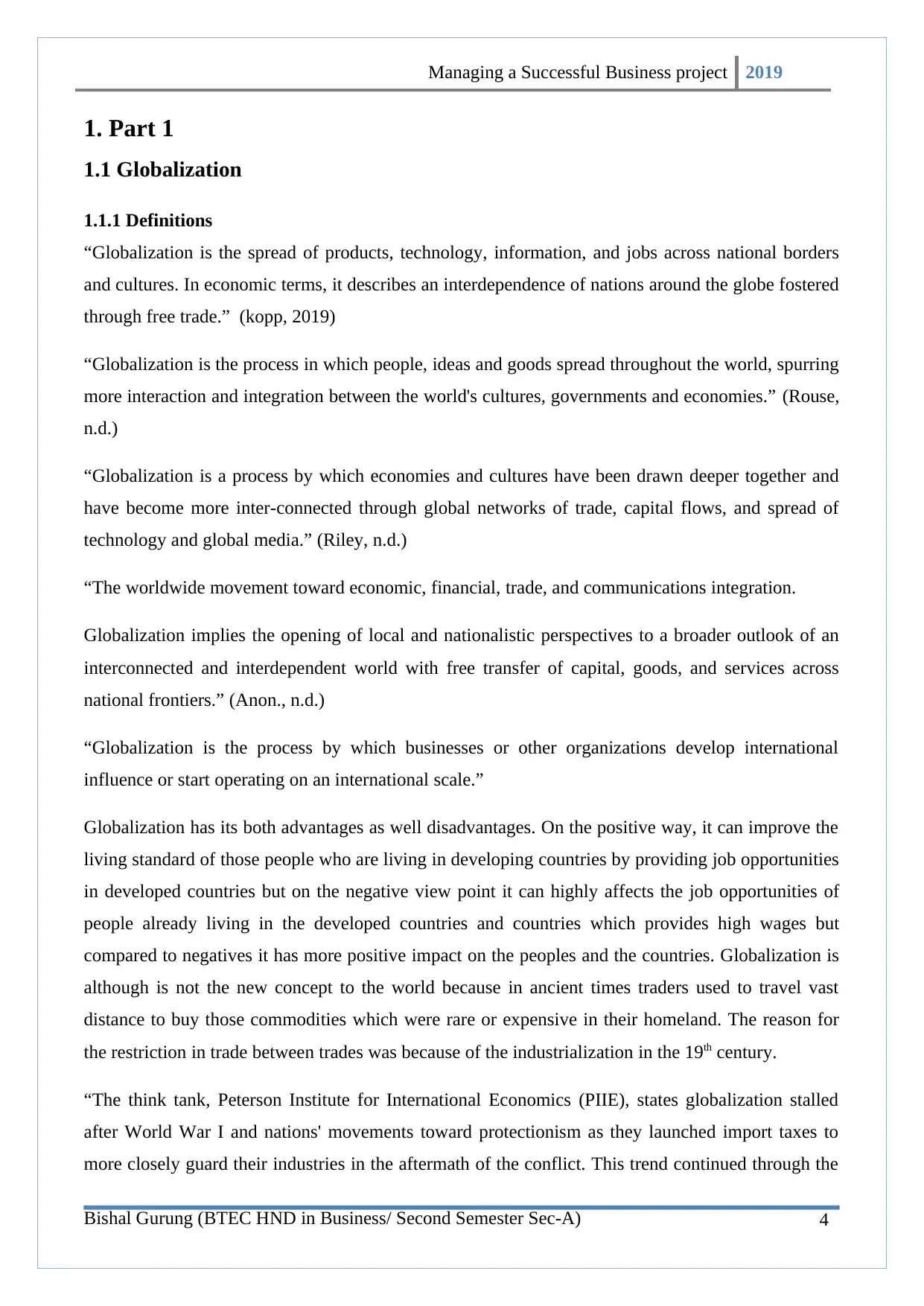
4
Managing a Successful Business project 2019
1. Part 1
1.1 Globalization
1.1.1 Definitions
“Globalization is the spread of products, technology, information, and jobs across national borders
and cultures. In economic terms, it describes an interdependence of nations around the globe fostered
through free trade.” (kopp, 2019)
“Globalization is the process in which people, ideas and goods spread throughout the world, spurring
more interaction and integration between the world's cultures, governments and economies.” (Rouse,
n.d.)
“Globalization is a process by which economies and cultures have been drawn deeper together and
have become more inter-connected through global networks of trade, capital flows, and spread of
technology and global media.” (Riley, n.d.)
“The worldwide movement toward economic, financial, trade, and communications integration.
Globalization implies the opening of local and nationalistic perspectives to a broader outlook of an
interconnected and interdependent world with free transfer of capital, goods, and services across
national frontiers.” (Anon., n.d.)
“Globalization is the process by which businesses or other organizations develop international
influence or start operating on an international scale.”
Globalization has its both advantages as well disadvantages. On the positive way, it can improve the
living standard of those people who are living in developing countries by providing job opportunities
in developed countries but on the negative view point it can highly affects the job opportunities of
people already living in the developed countries and countries which provides high wages but
compared to negatives it has more positive impact on the peoples and the countries. Globalization is
although is not the new concept to the world because in ancient times traders used to travel vast
distance to buy those commodities which were rare or expensive in their homeland. The reason for
the restriction in trade between trades was because of the industrialization in the 19th century.
“The think tank, Peterson Institute for International Economics (PIIE), states globalization stalled
after World War I and nations' movements toward protectionism as they launched import taxes to
more closely guard their industries in the aftermath of the conflict. This trend continued through the
Bishal Gurung (BTEC HND in Business/ Second Semester Sec-A)
Managing a Successful Business project 2019
1. Part 1
1.1 Globalization
1.1.1 Definitions
“Globalization is the spread of products, technology, information, and jobs across national borders
and cultures. In economic terms, it describes an interdependence of nations around the globe fostered
through free trade.” (kopp, 2019)
“Globalization is the process in which people, ideas and goods spread throughout the world, spurring
more interaction and integration between the world's cultures, governments and economies.” (Rouse,
n.d.)
“Globalization is a process by which economies and cultures have been drawn deeper together and
have become more inter-connected through global networks of trade, capital flows, and spread of
technology and global media.” (Riley, n.d.)
“The worldwide movement toward economic, financial, trade, and communications integration.
Globalization implies the opening of local and nationalistic perspectives to a broader outlook of an
interconnected and interdependent world with free transfer of capital, goods, and services across
national frontiers.” (Anon., n.d.)
“Globalization is the process by which businesses or other organizations develop international
influence or start operating on an international scale.”
Globalization has its both advantages as well disadvantages. On the positive way, it can improve the
living standard of those people who are living in developing countries by providing job opportunities
in developed countries but on the negative view point it can highly affects the job opportunities of
people already living in the developed countries and countries which provides high wages but
compared to negatives it has more positive impact on the peoples and the countries. Globalization is
although is not the new concept to the world because in ancient times traders used to travel vast
distance to buy those commodities which were rare or expensive in their homeland. The reason for
the restriction in trade between trades was because of the industrialization in the 19th century.
“The think tank, Peterson Institute for International Economics (PIIE), states globalization stalled
after World War I and nations' movements toward protectionism as they launched import taxes to
more closely guard their industries in the aftermath of the conflict. This trend continued through the
Bishal Gurung (BTEC HND in Business/ Second Semester Sec-A)
Paraphrase This Document
Need a fresh take? Get an instant paraphrase of this document with our AI Paraphraser
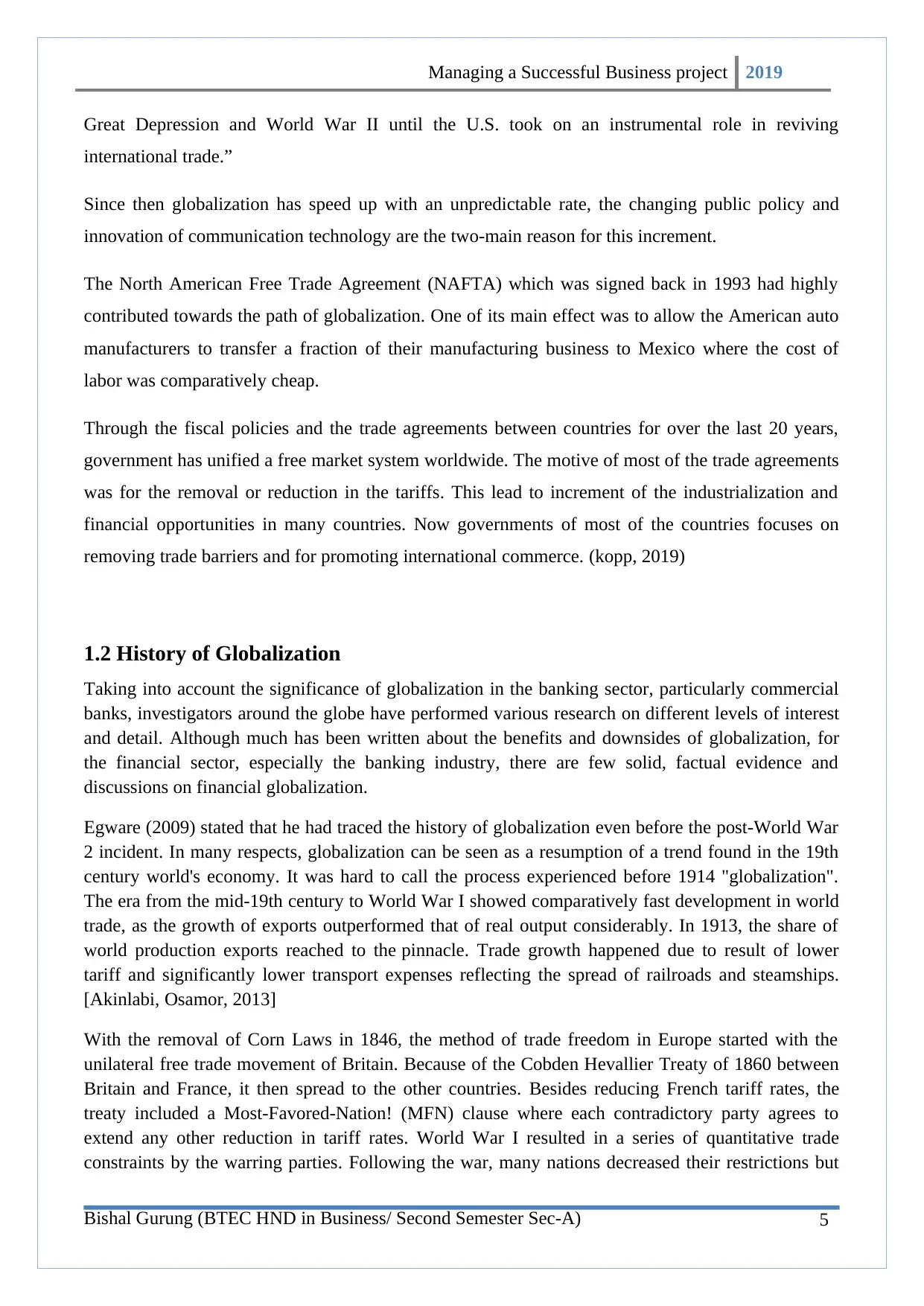
5
Managing a Successful Business project 2019
Great Depression and World War II until the U.S. took on an instrumental role in reviving
international trade.”
Since then globalization has speed up with an unpredictable rate, the changing public policy and
innovation of communication technology are the two-main reason for this increment.
The North American Free Trade Agreement (NAFTA) which was signed back in 1993 had highly
contributed towards the path of globalization. One of its main effect was to allow the American auto
manufacturers to transfer a fraction of their manufacturing business to Mexico where the cost of
labor was comparatively cheap.
Through the fiscal policies and the trade agreements between countries for over the last 20 years,
government has unified a free market system worldwide. The motive of most of the trade agreements
was for the removal or reduction in the tariffs. This lead to increment of the industrialization and
financial opportunities in many countries. Now governments of most of the countries focuses on
removing trade barriers and for promoting international commerce. (kopp, 2019)
1.2 History of Globalization
Taking into account the significance of globalization in the banking sector, particularly commercial
banks, investigators around the globe have performed various research on different levels of interest
and detail. Although much has been written about the benefits and downsides of globalization, for
the financial sector, especially the banking industry, there are few solid, factual evidence and
discussions on financial globalization.
Egware (2009) stated that he had traced the history of globalization even before the post-World War
2 incident. In many respects, globalization can be seen as a resumption of a trend found in the 19th
century world's economy. It was hard to call the process experienced before 1914 "globalization".
The era from the mid-19th century to World War I showed comparatively fast development in world
trade, as the growth of exports outperformed that of real output considerably. In 1913, the share of
world production exports reached to the pinnacle. Trade growth happened due to result of lower
tariff and significantly lower transport expenses reflecting the spread of railroads and steamships.
[Akinlabi, Osamor, 2013]
With the removal of Corn Laws in 1846, the method of trade freedom in Europe started with the
unilateral free trade movement of Britain. Because of the Cobden Hevallier Treaty of 1860 between
Britain and France, it then spread to the other countries. Besides reducing French tariff rates, the
treaty included a Most-Favored-Nation! (MFN) clause where each contradictory party agrees to
extend any other reduction in tariff rates. World War I resulted in a series of quantitative trade
constraints by the warring parties. Following the war, many nations decreased their restrictions but
Bishal Gurung (BTEC HND in Business/ Second Semester Sec-A)
Managing a Successful Business project 2019
Great Depression and World War II until the U.S. took on an instrumental role in reviving
international trade.”
Since then globalization has speed up with an unpredictable rate, the changing public policy and
innovation of communication technology are the two-main reason for this increment.
The North American Free Trade Agreement (NAFTA) which was signed back in 1993 had highly
contributed towards the path of globalization. One of its main effect was to allow the American auto
manufacturers to transfer a fraction of their manufacturing business to Mexico where the cost of
labor was comparatively cheap.
Through the fiscal policies and the trade agreements between countries for over the last 20 years,
government has unified a free market system worldwide. The motive of most of the trade agreements
was for the removal or reduction in the tariffs. This lead to increment of the industrialization and
financial opportunities in many countries. Now governments of most of the countries focuses on
removing trade barriers and for promoting international commerce. (kopp, 2019)
1.2 History of Globalization
Taking into account the significance of globalization in the banking sector, particularly commercial
banks, investigators around the globe have performed various research on different levels of interest
and detail. Although much has been written about the benefits and downsides of globalization, for
the financial sector, especially the banking industry, there are few solid, factual evidence and
discussions on financial globalization.
Egware (2009) stated that he had traced the history of globalization even before the post-World War
2 incident. In many respects, globalization can be seen as a resumption of a trend found in the 19th
century world's economy. It was hard to call the process experienced before 1914 "globalization".
The era from the mid-19th century to World War I showed comparatively fast development in world
trade, as the growth of exports outperformed that of real output considerably. In 1913, the share of
world production exports reached to the pinnacle. Trade growth happened due to result of lower
tariff and significantly lower transport expenses reflecting the spread of railroads and steamships.
[Akinlabi, Osamor, 2013]
With the removal of Corn Laws in 1846, the method of trade freedom in Europe started with the
unilateral free trade movement of Britain. Because of the Cobden Hevallier Treaty of 1860 between
Britain and France, it then spread to the other countries. Besides reducing French tariff rates, the
treaty included a Most-Favored-Nation! (MFN) clause where each contradictory party agrees to
extend any other reduction in tariff rates. World War I resulted in a series of quantitative trade
constraints by the warring parties. Following the war, many nations decreased their restrictions but
Bishal Gurung (BTEC HND in Business/ Second Semester Sec-A)
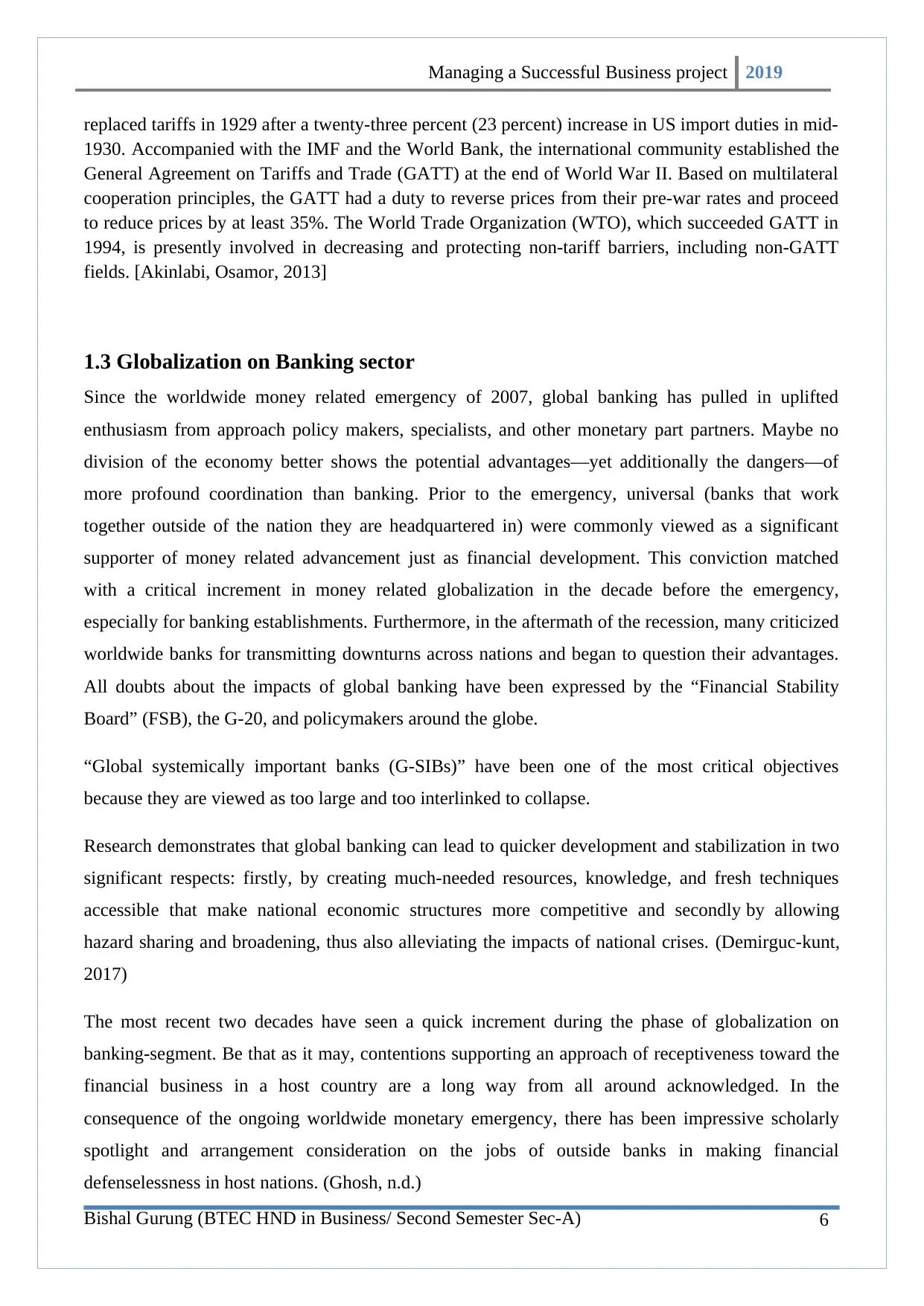
6
Managing a Successful Business project 2019
replaced tariffs in 1929 after a twenty-three percent (23 percent) increase in US import duties in mid-
1930. Accompanied with the IMF and the World Bank, the international community established the
General Agreement on Tariffs and Trade (GATT) at the end of World War II. Based on multilateral
cooperation principles, the GATT had a duty to reverse prices from their pre-war rates and proceed
to reduce prices by at least 35%. The World Trade Organization (WTO), which succeeded GATT in
1994, is presently involved in decreasing and protecting non-tariff barriers, including non-GATT
fields. [Akinlabi, Osamor, 2013]
1.3 Globalization on Banking sector
Since the worldwide money related emergency of 2007, global banking has pulled in uplifted
enthusiasm from approach policy makers, specialists, and other monetary part partners. Maybe no
division of the economy better shows the potential advantages—yet additionally the dangers—of
more profound coordination than banking. Prior to the emergency, universal (banks that work
together outside of the nation they are headquartered in) were commonly viewed as a significant
supporter of money related advancement just as financial development. This conviction matched
with a critical increment in money related globalization in the decade before the emergency,
especially for banking establishments. Furthermore, in the aftermath of the recession, many criticized
worldwide banks for transmitting downturns across nations and began to question their advantages.
All doubts about the impacts of global banking have been expressed by the “Financial Stability
Board” (FSB), the G-20, and policymakers around the globe.
“Global systemically important banks (G-SIBs)” have been one of the most critical objectives
because they are viewed as too large and too interlinked to collapse.
Research demonstrates that global banking can lead to quicker development and stabilization in two
significant respects: firstly, by creating much-needed resources, knowledge, and fresh techniques
accessible that make national economic structures more competitive and secondly by allowing
hazard sharing and broadening, thus also alleviating the impacts of national crises. (Demirguc-kunt,
2017)
The most recent two decades have seen a quick increment during the phase of globalization on
banking-segment. Be that as it may, contentions supporting an approach of receptiveness toward the
financial business in a host country are a long way from all around acknowledged. In the
consequence of the ongoing worldwide monetary emergency, there has been impressive scholarly
spotlight and arrangement consideration on the jobs of outside banks in making financial
defenselessness in host nations. (Ghosh, n.d.)
Bishal Gurung (BTEC HND in Business/ Second Semester Sec-A)
Managing a Successful Business project 2019
replaced tariffs in 1929 after a twenty-three percent (23 percent) increase in US import duties in mid-
1930. Accompanied with the IMF and the World Bank, the international community established the
General Agreement on Tariffs and Trade (GATT) at the end of World War II. Based on multilateral
cooperation principles, the GATT had a duty to reverse prices from their pre-war rates and proceed
to reduce prices by at least 35%. The World Trade Organization (WTO), which succeeded GATT in
1994, is presently involved in decreasing and protecting non-tariff barriers, including non-GATT
fields. [Akinlabi, Osamor, 2013]
1.3 Globalization on Banking sector
Since the worldwide money related emergency of 2007, global banking has pulled in uplifted
enthusiasm from approach policy makers, specialists, and other monetary part partners. Maybe no
division of the economy better shows the potential advantages—yet additionally the dangers—of
more profound coordination than banking. Prior to the emergency, universal (banks that work
together outside of the nation they are headquartered in) were commonly viewed as a significant
supporter of money related advancement just as financial development. This conviction matched
with a critical increment in money related globalization in the decade before the emergency,
especially for banking establishments. Furthermore, in the aftermath of the recession, many criticized
worldwide banks for transmitting downturns across nations and began to question their advantages.
All doubts about the impacts of global banking have been expressed by the “Financial Stability
Board” (FSB), the G-20, and policymakers around the globe.
“Global systemically important banks (G-SIBs)” have been one of the most critical objectives
because they are viewed as too large and too interlinked to collapse.
Research demonstrates that global banking can lead to quicker development and stabilization in two
significant respects: firstly, by creating much-needed resources, knowledge, and fresh techniques
accessible that make national economic structures more competitive and secondly by allowing
hazard sharing and broadening, thus also alleviating the impacts of national crises. (Demirguc-kunt,
2017)
The most recent two decades have seen a quick increment during the phase of globalization on
banking-segment. Be that as it may, contentions supporting an approach of receptiveness toward the
financial business in a host country are a long way from all around acknowledged. In the
consequence of the ongoing worldwide monetary emergency, there has been impressive scholarly
spotlight and arrangement consideration on the jobs of outside banks in making financial
defenselessness in host nations. (Ghosh, n.d.)
Bishal Gurung (BTEC HND in Business/ Second Semester Sec-A)
⊘ This is a preview!⊘
Do you want full access?
Subscribe today to unlock all pages.

Trusted by 1+ million students worldwide
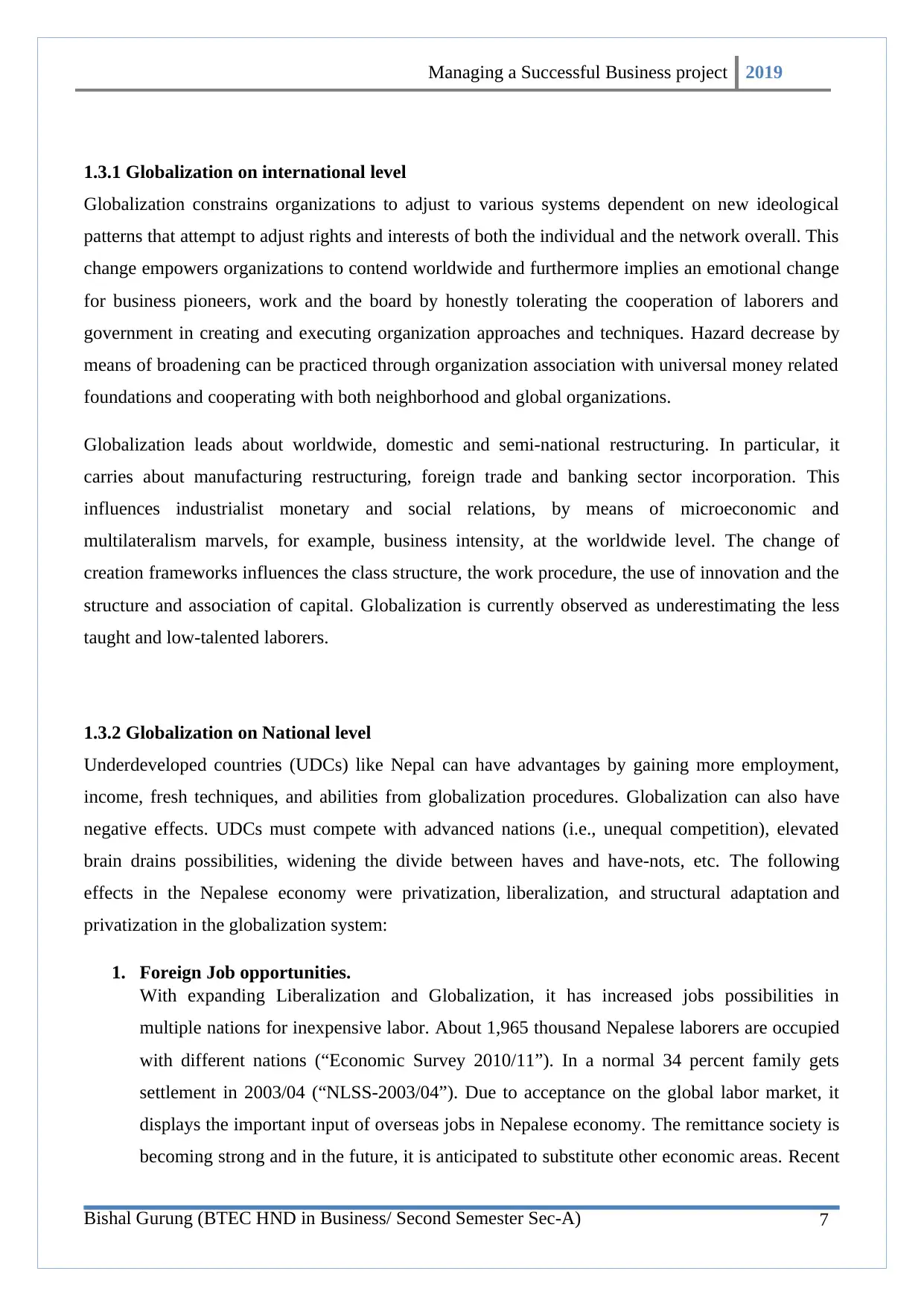
7
Managing a Successful Business project 2019
1.3.1 Globalization on international level
Globalization constrains organizations to adjust to various systems dependent on new ideological
patterns that attempt to adjust rights and interests of both the individual and the network overall. This
change empowers organizations to contend worldwide and furthermore implies an emotional change
for business pioneers, work and the board by honestly tolerating the cooperation of laborers and
government in creating and executing organization approaches and techniques. Hazard decrease by
means of broadening can be practiced through organization association with universal money related
foundations and cooperating with both neighborhood and global organizations.
Globalization leads about worldwide, domestic and semi-national restructuring. In particular, it
carries about manufacturing restructuring, foreign trade and banking sector incorporation. This
influences industrialist monetary and social relations, by means of microeconomic and
multilateralism marvels, for example, business intensity, at the worldwide level. The change of
creation frameworks influences the class structure, the work procedure, the use of innovation and the
structure and association of capital. Globalization is currently observed as underestimating the less
taught and low-talented laborers.
1.3.2 Globalization on National level
Underdeveloped countries (UDCs) like Nepal can have advantages by gaining more employment,
income, fresh techniques, and abilities from globalization procedures. Globalization can also have
negative effects. UDCs must compete with advanced nations (i.e., unequal competition), elevated
brain drains possibilities, widening the divide between haves and have-nots, etc. The following
effects in the Nepalese economy were privatization, liberalization, and structural adaptation and
privatization in the globalization system:
1. Foreign Job opportunities.
With expanding Liberalization and Globalization, it has increased jobs possibilities in
multiple nations for inexpensive labor. About 1,965 thousand Nepalese laborers are occupied
with different nations (“Economic Survey 2010/11”). In a normal 34 percent family gets
settlement in 2003/04 (“NLSS-2003/04”). Due to acceptance on the global labor market, it
displays the important input of overseas jobs in Nepalese economy. The remittance society is
becoming strong and in the future, it is anticipated to substitute other economic areas. Recent
Bishal Gurung (BTEC HND in Business/ Second Semester Sec-A)
Managing a Successful Business project 2019
1.3.1 Globalization on international level
Globalization constrains organizations to adjust to various systems dependent on new ideological
patterns that attempt to adjust rights and interests of both the individual and the network overall. This
change empowers organizations to contend worldwide and furthermore implies an emotional change
for business pioneers, work and the board by honestly tolerating the cooperation of laborers and
government in creating and executing organization approaches and techniques. Hazard decrease by
means of broadening can be practiced through organization association with universal money related
foundations and cooperating with both neighborhood and global organizations.
Globalization leads about worldwide, domestic and semi-national restructuring. In particular, it
carries about manufacturing restructuring, foreign trade and banking sector incorporation. This
influences industrialist monetary and social relations, by means of microeconomic and
multilateralism marvels, for example, business intensity, at the worldwide level. The change of
creation frameworks influences the class structure, the work procedure, the use of innovation and the
structure and association of capital. Globalization is currently observed as underestimating the less
taught and low-talented laborers.
1.3.2 Globalization on National level
Underdeveloped countries (UDCs) like Nepal can have advantages by gaining more employment,
income, fresh techniques, and abilities from globalization procedures. Globalization can also have
negative effects. UDCs must compete with advanced nations (i.e., unequal competition), elevated
brain drains possibilities, widening the divide between haves and have-nots, etc. The following
effects in the Nepalese economy were privatization, liberalization, and structural adaptation and
privatization in the globalization system:
1. Foreign Job opportunities.
With expanding Liberalization and Globalization, it has increased jobs possibilities in
multiple nations for inexpensive labor. About 1,965 thousand Nepalese laborers are occupied
with different nations (“Economic Survey 2010/11”). In a normal 34 percent family gets
settlement in 2003/04 (“NLSS-2003/04”). Due to acceptance on the global labor market, it
displays the important input of overseas jobs in Nepalese economy. The remittance society is
becoming strong and in the future, it is anticipated to substitute other economic areas. Recent
Bishal Gurung (BTEC HND in Business/ Second Semester Sec-A)
Paraphrase This Document
Need a fresh take? Get an instant paraphrase of this document with our AI Paraphraser
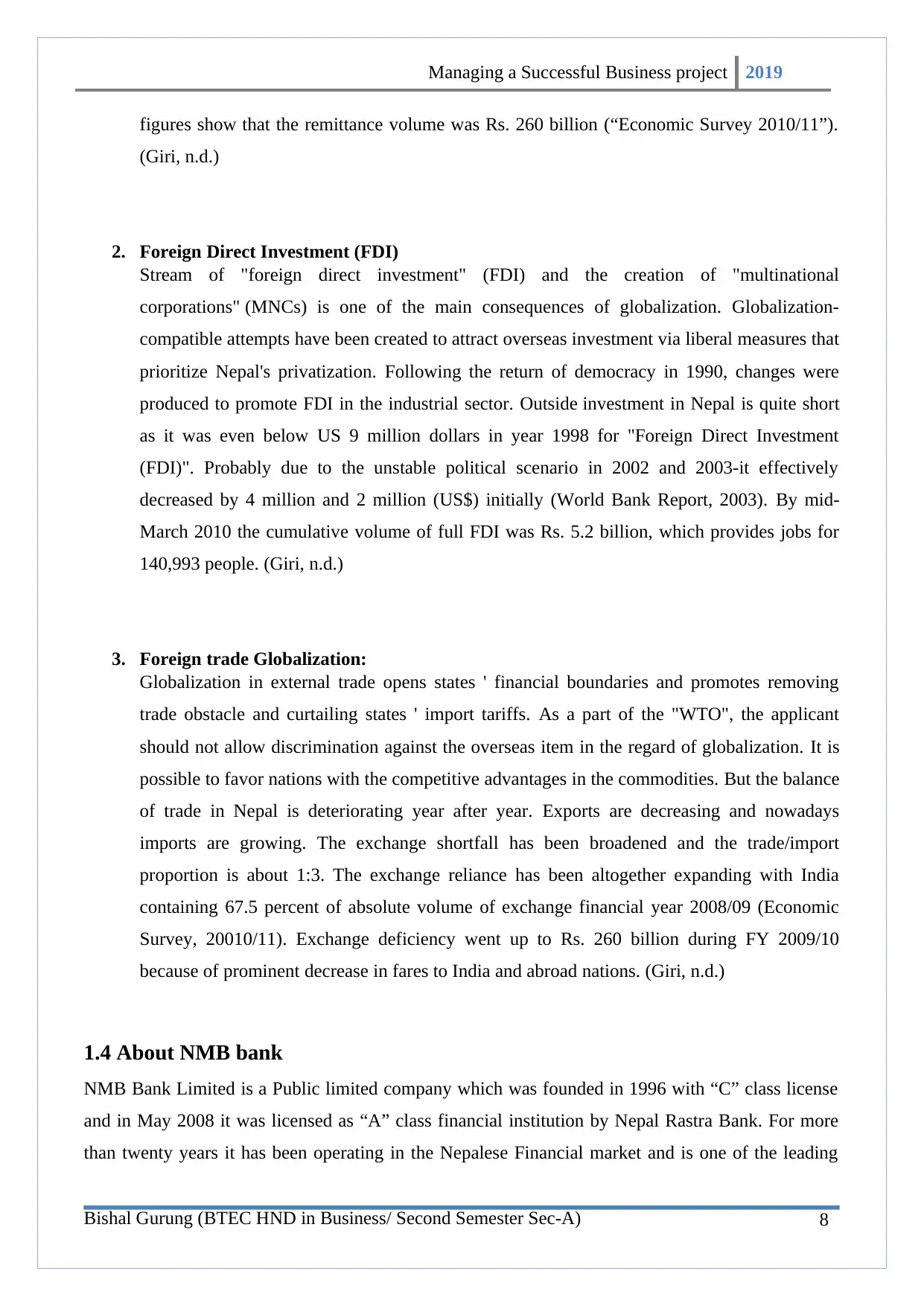
8
Managing a Successful Business project 2019
figures show that the remittance volume was Rs. 260 billion (“Economic Survey 2010/11”).
(Giri, n.d.)
2. Foreign Direct Investment (FDI)
Stream of "foreign direct investment" (FDI) and the creation of "multinational
corporations" (MNCs) is one of the main consequences of globalization. Globalization-
compatible attempts have been created to attract overseas investment via liberal measures that
prioritize Nepal's privatization. Following the return of democracy in 1990, changes were
produced to promote FDI in the industrial sector. Outside investment in Nepal is quite short
as it was even below US 9 million dollars in year 1998 for "Foreign Direct Investment
(FDI)". Probably due to the unstable political scenario in 2002 and 2003-it effectively
decreased by 4 million and 2 million (US$) initially (World Bank Report, 2003). By mid-
March 2010 the cumulative volume of full FDI was Rs. 5.2 billion, which provides jobs for
140,993 people. (Giri, n.d.)
3. Foreign trade Globalization:
Globalization in external trade opens states ' financial boundaries and promotes removing
trade obstacle and curtailing states ' import tariffs. As a part of the "WTO", the applicant
should not allow discrimination against the overseas item in the regard of globalization. It is
possible to favor nations with the competitive advantages in the commodities. But the balance
of trade in Nepal is deteriorating year after year. Exports are decreasing and nowadays
imports are growing. The exchange shortfall has been broadened and the trade/import
proportion is about 1:3. The exchange reliance has been altogether expanding with India
containing 67.5 percent of absolute volume of exchange financial year 2008/09 (Economic
Survey, 20010/11). Exchange deficiency went up to Rs. 260 billion during FY 2009/10
because of prominent decrease in fares to India and abroad nations. (Giri, n.d.)
1.4 About NMB bank
NMB Bank Limited is a Public limited company which was founded in 1996 with “C” class license
and in May 2008 it was licensed as “A” class financial institution by Nepal Rastra Bank. For more
than twenty years it has been operating in the Nepalese Financial market and is one of the leading
Bishal Gurung (BTEC HND in Business/ Second Semester Sec-A)
Managing a Successful Business project 2019
figures show that the remittance volume was Rs. 260 billion (“Economic Survey 2010/11”).
(Giri, n.d.)
2. Foreign Direct Investment (FDI)
Stream of "foreign direct investment" (FDI) and the creation of "multinational
corporations" (MNCs) is one of the main consequences of globalization. Globalization-
compatible attempts have been created to attract overseas investment via liberal measures that
prioritize Nepal's privatization. Following the return of democracy in 1990, changes were
produced to promote FDI in the industrial sector. Outside investment in Nepal is quite short
as it was even below US 9 million dollars in year 1998 for "Foreign Direct Investment
(FDI)". Probably due to the unstable political scenario in 2002 and 2003-it effectively
decreased by 4 million and 2 million (US$) initially (World Bank Report, 2003). By mid-
March 2010 the cumulative volume of full FDI was Rs. 5.2 billion, which provides jobs for
140,993 people. (Giri, n.d.)
3. Foreign trade Globalization:
Globalization in external trade opens states ' financial boundaries and promotes removing
trade obstacle and curtailing states ' import tariffs. As a part of the "WTO", the applicant
should not allow discrimination against the overseas item in the regard of globalization. It is
possible to favor nations with the competitive advantages in the commodities. But the balance
of trade in Nepal is deteriorating year after year. Exports are decreasing and nowadays
imports are growing. The exchange shortfall has been broadened and the trade/import
proportion is about 1:3. The exchange reliance has been altogether expanding with India
containing 67.5 percent of absolute volume of exchange financial year 2008/09 (Economic
Survey, 20010/11). Exchange deficiency went up to Rs. 260 billion during FY 2009/10
because of prominent decrease in fares to India and abroad nations. (Giri, n.d.)
1.4 About NMB bank
NMB Bank Limited is a Public limited company which was founded in 1996 with “C” class license
and in May 2008 it was licensed as “A” class financial institution by Nepal Rastra Bank. For more
than twenty years it has been operating in the Nepalese Financial market and is one of the leading
Bishal Gurung (BTEC HND in Business/ Second Semester Sec-A)
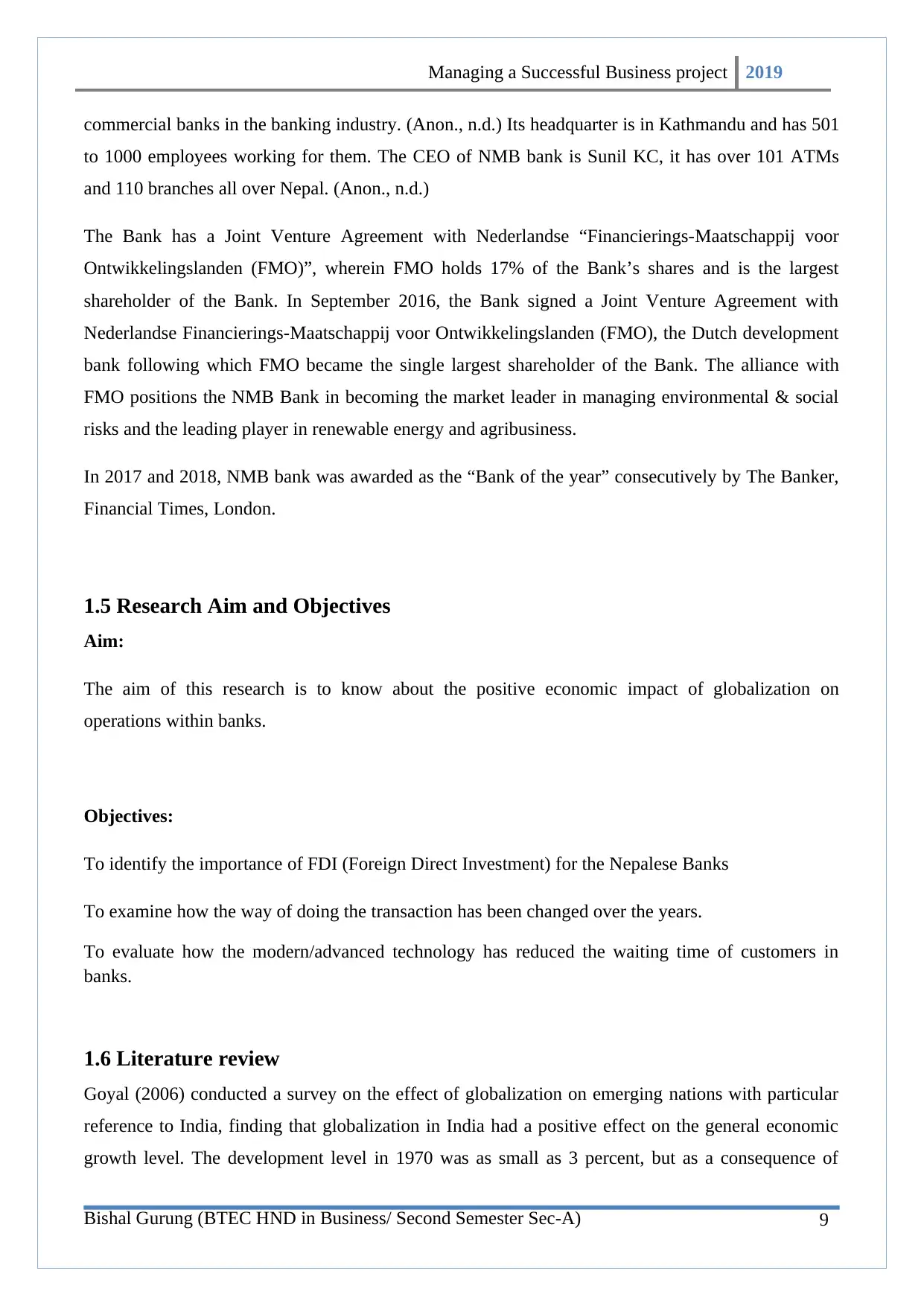
9
Managing a Successful Business project 2019
commercial banks in the banking industry. (Anon., n.d.) Its headquarter is in Kathmandu and has 501
to 1000 employees working for them. The CEO of NMB bank is Sunil KC, it has over 101 ATMs
and 110 branches all over Nepal. (Anon., n.d.)
The Bank has a Joint Venture Agreement with Nederlandse “Financierings-Maatschappij voor
Ontwikkelingslanden (FMO)”, wherein FMO holds 17% of the Bank’s shares and is the largest
shareholder of the Bank. In September 2016, the Bank signed a Joint Venture Agreement with
Nederlandse Financierings-Maatschappij voor Ontwikkelingslanden (FMO), the Dutch development
bank following which FMO became the single largest shareholder of the Bank. The alliance with
FMO positions the NMB Bank in becoming the market leader in managing environmental & social
risks and the leading player in renewable energy and agribusiness.
In 2017 and 2018, NMB bank was awarded as the “Bank of the year” consecutively by The Banker,
Financial Times, London.
1.5 Research Aim and Objectives
Aim:
The aim of this research is to know about the positive economic impact of globalization on
operations within banks.
Objectives:
To identify the importance of FDI (Foreign Direct Investment) for the Nepalese Banks
To examine how the way of doing the transaction has been changed over the years.
To evaluate how the modern/advanced technology has reduced the waiting time of customers in
banks.
1.6 Literature review
Goyal (2006) conducted a survey on the effect of globalization on emerging nations with particular
reference to India, finding that globalization in India had a positive effect on the general economic
growth level. The development level in 1970 was as small as 3 percent, but as a consequence of
Bishal Gurung (BTEC HND in Business/ Second Semester Sec-A)
Managing a Successful Business project 2019
commercial banks in the banking industry. (Anon., n.d.) Its headquarter is in Kathmandu and has 501
to 1000 employees working for them. The CEO of NMB bank is Sunil KC, it has over 101 ATMs
and 110 branches all over Nepal. (Anon., n.d.)
The Bank has a Joint Venture Agreement with Nederlandse “Financierings-Maatschappij voor
Ontwikkelingslanden (FMO)”, wherein FMO holds 17% of the Bank’s shares and is the largest
shareholder of the Bank. In September 2016, the Bank signed a Joint Venture Agreement with
Nederlandse Financierings-Maatschappij voor Ontwikkelingslanden (FMO), the Dutch development
bank following which FMO became the single largest shareholder of the Bank. The alliance with
FMO positions the NMB Bank in becoming the market leader in managing environmental & social
risks and the leading player in renewable energy and agribusiness.
In 2017 and 2018, NMB bank was awarded as the “Bank of the year” consecutively by The Banker,
Financial Times, London.
1.5 Research Aim and Objectives
Aim:
The aim of this research is to know about the positive economic impact of globalization on
operations within banks.
Objectives:
To identify the importance of FDI (Foreign Direct Investment) for the Nepalese Banks
To examine how the way of doing the transaction has been changed over the years.
To evaluate how the modern/advanced technology has reduced the waiting time of customers in
banks.
1.6 Literature review
Goyal (2006) conducted a survey on the effect of globalization on emerging nations with particular
reference to India, finding that globalization in India had a positive effect on the general economic
growth level. The development level in 1970 was as small as 3 percent, but as a consequence of
Bishal Gurung (BTEC HND in Business/ Second Semester Sec-A)
⊘ This is a preview!⊘
Do you want full access?
Subscribe today to unlock all pages.

Trusted by 1+ million students worldwide

10
Managing a Successful Business project 2019
globalization it then nearly doubled to 5.9 percent in the 1980s. Studies have shown that
globalization has affected various economies in various ways.
Commercial banks ' effectiveness and performance has been widely researched over the past several
centuries. For example, Ferrier and Lovell (1990), Elyasiani and Mehdian (1992), etc. use the Data
Envelope Analysis (DEA) strategy to evaluate the U.S. commercial banks ' output efficiency against
several best practiced boundaries. The empirical results of these research indicate that the U.S.
finance industry's general effectiveness in the 1980s and 1990s ranged from 65% to 90%. There has
also been comprehensive research of the results of companies working in non-U.S. nations. For
example, Berg et al. (1992) and Berger et al. (1993) evaluate the efficiency and productivity growth
of Northern finance industries and claim Swedish banks are the most effective, followed by
Norwegian banks and then Finnish banks. Pastor et al. (1997) evaluated and compare banking
industry effectiveness in Europe and the United States. These researchers report that banks operating
in France, Spain, and Belgium are the most effective banks in their samples, while banks working in
the United Kingdom, Austria, and Germany show the smallest rates of effectiveness.
“Lozano-Vivas et al. (2002)” examine the efficiency of a group of companies in 10 European nations
and find that nation-specific surroundings circumstances have a major impact on the performance of
the banking sector on every nation.
When thought in an economical sense, globalization relates to reducing and removing obstacles
between domestic boundaries to promote the flow of products, investment, facilities and manpower.
Globalization has affected the way banking operation that has been performed globally and
Zimbabwe has not been excluded. The check has lost its supremacy as a billing tool in most banking
environments after the emergence of “EFTPOS (Electronic Funds Transfer at Point of Sale)”, direct
debit, immediate credit, and online banking. This has resulted legal experts to propose that the check-
based concept should be extended to include financial entities that operate current accounts for
individuals and allow third-party payments and payments to clients, although they don't pay and
receive.
Automated Teller Machines (ATMs), a computerized broadcasting device that offers clients of a
finance company with a technique of monetary operations in a public area that does not requires a
human attendant or bank teller, has significantly affected branch systems. In many marketplaces,
telephone, Smartphones, live stream and internet banking substituted person-to-
person communication with the agent. Rose defined cellphone banking as a service offered by a
bank's that enables its clients to conduct cellphone operations. Mobile banking is a phrase used to
conduct operations, transfers, and many more throughout the Internet under a secure site of a bank,
credit union. Net banking is a technique of using one's smartphone to perform easy banking
operations by connecting to a banking network digitally, according to Koch (2008). Koch defined
video banking as being used by distant video and audio connections to execute banking operations or
skilled banking counselling sessions. Video banking may be conducted using built-in banking
Bishal Gurung (BTEC HND in Business/ Second Semester Sec-A)
Managing a Successful Business project 2019
globalization it then nearly doubled to 5.9 percent in the 1980s. Studies have shown that
globalization has affected various economies in various ways.
Commercial banks ' effectiveness and performance has been widely researched over the past several
centuries. For example, Ferrier and Lovell (1990), Elyasiani and Mehdian (1992), etc. use the Data
Envelope Analysis (DEA) strategy to evaluate the U.S. commercial banks ' output efficiency against
several best practiced boundaries. The empirical results of these research indicate that the U.S.
finance industry's general effectiveness in the 1980s and 1990s ranged from 65% to 90%. There has
also been comprehensive research of the results of companies working in non-U.S. nations. For
example, Berg et al. (1992) and Berger et al. (1993) evaluate the efficiency and productivity growth
of Northern finance industries and claim Swedish banks are the most effective, followed by
Norwegian banks and then Finnish banks. Pastor et al. (1997) evaluated and compare banking
industry effectiveness in Europe and the United States. These researchers report that banks operating
in France, Spain, and Belgium are the most effective banks in their samples, while banks working in
the United Kingdom, Austria, and Germany show the smallest rates of effectiveness.
“Lozano-Vivas et al. (2002)” examine the efficiency of a group of companies in 10 European nations
and find that nation-specific surroundings circumstances have a major impact on the performance of
the banking sector on every nation.
When thought in an economical sense, globalization relates to reducing and removing obstacles
between domestic boundaries to promote the flow of products, investment, facilities and manpower.
Globalization has affected the way banking operation that has been performed globally and
Zimbabwe has not been excluded. The check has lost its supremacy as a billing tool in most banking
environments after the emergence of “EFTPOS (Electronic Funds Transfer at Point of Sale)”, direct
debit, immediate credit, and online banking. This has resulted legal experts to propose that the check-
based concept should be extended to include financial entities that operate current accounts for
individuals and allow third-party payments and payments to clients, although they don't pay and
receive.
Automated Teller Machines (ATMs), a computerized broadcasting device that offers clients of a
finance company with a technique of monetary operations in a public area that does not requires a
human attendant or bank teller, has significantly affected branch systems. In many marketplaces,
telephone, Smartphones, live stream and internet banking substituted person-to-
person communication with the agent. Rose defined cellphone banking as a service offered by a
bank's that enables its clients to conduct cellphone operations. Mobile banking is a phrase used to
conduct operations, transfers, and many more throughout the Internet under a secure site of a bank,
credit union. Net banking is a technique of using one's smartphone to perform easy banking
operations by connecting to a banking network digitally, according to Koch (2008). Koch defined
video banking as being used by distant video and audio connections to execute banking operations or
skilled banking counselling sessions. Video banking may be conducted using built-in banking
Bishal Gurung (BTEC HND in Business/ Second Semester Sec-A)
Paraphrase This Document
Need a fresh take? Get an instant paraphrase of this document with our AI Paraphraser
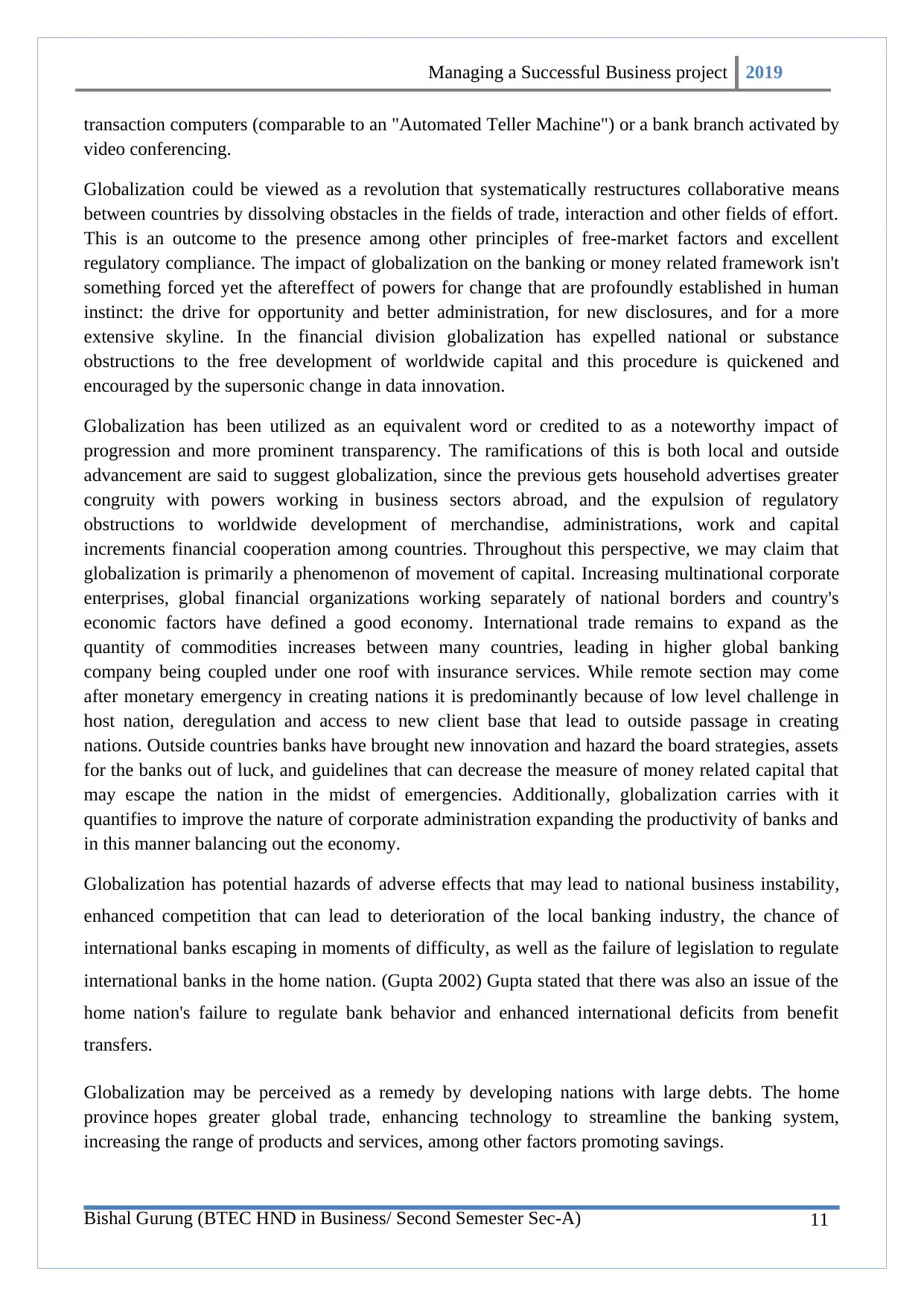
11
Managing a Successful Business project 2019
transaction computers (comparable to an "Automated Teller Machine") or a bank branch activated by
video conferencing.
Globalization could be viewed as a revolution that systematically restructures collaborative means
between countries by dissolving obstacles in the fields of trade, interaction and other fields of effort.
This is an outcome to the presence among other principles of free-market factors and excellent
regulatory compliance. The impact of globalization on the banking or money related framework isn't
something forced yet the aftereffect of powers for change that are profoundly established in human
instinct: the drive for opportunity and better administration, for new disclosures, and for a more
extensive skyline. In the financial division globalization has expelled national or substance
obstructions to the free development of worldwide capital and this procedure is quickened and
encouraged by the supersonic change in data innovation.
Globalization has been utilized as an equivalent word or credited to as a noteworthy impact of
progression and more prominent transparency. The ramifications of this is both local and outside
advancement are said to suggest globalization, since the previous gets household advertises greater
congruity with powers working in business sectors abroad, and the expulsion of regulatory
obstructions to worldwide development of merchandise, administrations, work and capital
increments financial cooperation among countries. Throughout this perspective, we may claim that
globalization is primarily a phenomenon of movement of capital. Increasing multinational corporate
enterprises, global financial organizations working separately of national borders and country's
economic factors have defined a good economy. International trade remains to expand as the
quantity of commodities increases between many countries, leading in higher global banking
company being coupled under one roof with insurance services. While remote section may come
after monetary emergency in creating nations it is predominantly because of low level challenge in
host nation, deregulation and access to new client base that lead to outside passage in creating
nations. Outside countries banks have brought new innovation and hazard the board strategies, assets
for the banks out of luck, and guidelines that can decrease the measure of money related capital that
may escape the nation in the midst of emergencies. Additionally, globalization carries with it
quantifies to improve the nature of corporate administration expanding the productivity of banks and
in this manner balancing out the economy.
Globalization has potential hazards of adverse effects that may lead to national business instability,
enhanced competition that can lead to deterioration of the local banking industry, the chance of
international banks escaping in moments of difficulty, as well as the failure of legislation to regulate
international banks in the home nation. (Gupta 2002) Gupta stated that there was also an issue of the
home nation's failure to regulate bank behavior and enhanced international deficits from benefit
transfers.
Globalization may be perceived as a remedy by developing nations with large debts. The home
province hopes greater global trade, enhancing technology to streamline the banking system,
increasing the range of products and services, among other factors promoting savings.
Bishal Gurung (BTEC HND in Business/ Second Semester Sec-A)
Managing a Successful Business project 2019
transaction computers (comparable to an "Automated Teller Machine") or a bank branch activated by
video conferencing.
Globalization could be viewed as a revolution that systematically restructures collaborative means
between countries by dissolving obstacles in the fields of trade, interaction and other fields of effort.
This is an outcome to the presence among other principles of free-market factors and excellent
regulatory compliance. The impact of globalization on the banking or money related framework isn't
something forced yet the aftereffect of powers for change that are profoundly established in human
instinct: the drive for opportunity and better administration, for new disclosures, and for a more
extensive skyline. In the financial division globalization has expelled national or substance
obstructions to the free development of worldwide capital and this procedure is quickened and
encouraged by the supersonic change in data innovation.
Globalization has been utilized as an equivalent word or credited to as a noteworthy impact of
progression and more prominent transparency. The ramifications of this is both local and outside
advancement are said to suggest globalization, since the previous gets household advertises greater
congruity with powers working in business sectors abroad, and the expulsion of regulatory
obstructions to worldwide development of merchandise, administrations, work and capital
increments financial cooperation among countries. Throughout this perspective, we may claim that
globalization is primarily a phenomenon of movement of capital. Increasing multinational corporate
enterprises, global financial organizations working separately of national borders and country's
economic factors have defined a good economy. International trade remains to expand as the
quantity of commodities increases between many countries, leading in higher global banking
company being coupled under one roof with insurance services. While remote section may come
after monetary emergency in creating nations it is predominantly because of low level challenge in
host nation, deregulation and access to new client base that lead to outside passage in creating
nations. Outside countries banks have brought new innovation and hazard the board strategies, assets
for the banks out of luck, and guidelines that can decrease the measure of money related capital that
may escape the nation in the midst of emergencies. Additionally, globalization carries with it
quantifies to improve the nature of corporate administration expanding the productivity of banks and
in this manner balancing out the economy.
Globalization has potential hazards of adverse effects that may lead to national business instability,
enhanced competition that can lead to deterioration of the local banking industry, the chance of
international banks escaping in moments of difficulty, as well as the failure of legislation to regulate
international banks in the home nation. (Gupta 2002) Gupta stated that there was also an issue of the
home nation's failure to regulate bank behavior and enhanced international deficits from benefit
transfers.
Globalization may be perceived as a remedy by developing nations with large debts. The home
province hopes greater global trade, enhancing technology to streamline the banking system,
increasing the range of products and services, among other factors promoting savings.
Bishal Gurung (BTEC HND in Business/ Second Semester Sec-A)
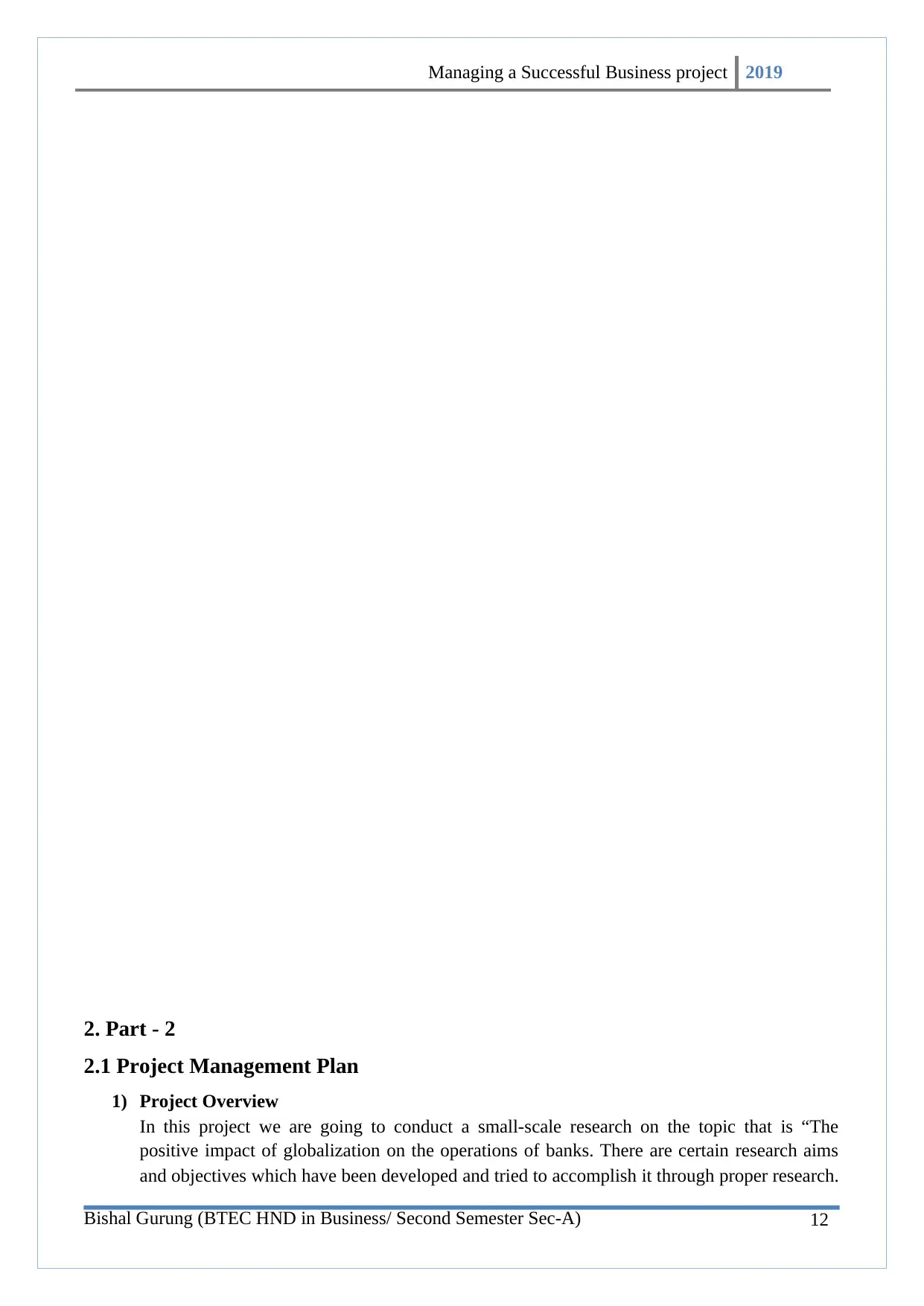
12
Managing a Successful Business project 2019
2. Part - 2
2.1 Project Management Plan
1) Project Overview
In this project we are going to conduct a small-scale research on the topic that is “The
positive impact of globalization on the operations of banks. There are certain research aims
and objectives which have been developed and tried to accomplish it through proper research.
Bishal Gurung (BTEC HND in Business/ Second Semester Sec-A)
Managing a Successful Business project 2019
2. Part - 2
2.1 Project Management Plan
1) Project Overview
In this project we are going to conduct a small-scale research on the topic that is “The
positive impact of globalization on the operations of banks. There are certain research aims
and objectives which have been developed and tried to accomplish it through proper research.
Bishal Gurung (BTEC HND in Business/ Second Semester Sec-A)
⊘ This is a preview!⊘
Do you want full access?
Subscribe today to unlock all pages.

Trusted by 1+ million students worldwide
1 out of 44
Related Documents
Your All-in-One AI-Powered Toolkit for Academic Success.
+13062052269
info@desklib.com
Available 24*7 on WhatsApp / Email
![[object Object]](/_next/static/media/star-bottom.7253800d.svg)
Unlock your academic potential
Copyright © 2020–2025 A2Z Services. All Rights Reserved. Developed and managed by ZUCOL.

